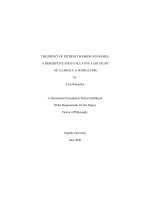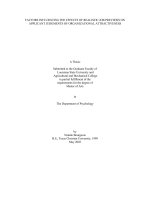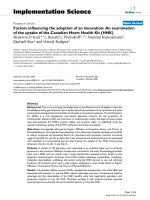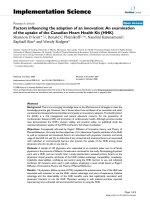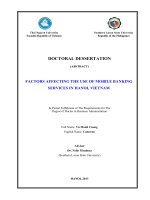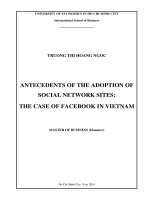Factors influencing the adoption of internet banking unlocked
Bạn đang xem bản rút gọn của tài liệu. Xem và tải ngay bản đầy đủ của tài liệu tại đây (1.96 MB, 113 trang )
2008:099
MASTER'S THESIS
Factors Influencing the Adoption
of Internet Banking
Sara Naimi Baraghani
Luleå University of Technology
Master Thesis, Continuation Courses
Marketing and e-commerce
Department of Business Administration and Social Sciences
Division of Industrial marketing and e-commerce
2008:099 - ISSN: 1653-0187 - ISRN: LTU-PB-EX 08/099 SE
MASTER'S THESIS
Factors Influencing the Adoption of Internet
Banking
Supervisors:
Dr. Seyed Hessameddin Zegordi
Dr. Mohammed Khalifa
Prepared by:
Sara Naimi Baraghani
836831026
Tarbiat Modares University Faculty of Engineering
Department of Industrial Engineering
Lulea University of Technology
Division of Industrial Marketing and E-Commerce
Joint MSc PROGRAM IN MARKETING AND ELECTRONIC COMMERCE
2007
Abstract
This thesis reports the findings of a study issues concerning the adoption of
internet banking in Iran. This study investigates costumers' adoption within the context of
Iran Internet Banking services and research framework is based on the extension of
Technology Acceptance Model with Theory of Planned behavior and Trust.
Theory was developed to identify factors that would influence the adoption of
Internet banking. The framework includes Attitude, subjective norm, Perceived
behavioral control, Perceived usefulness, Perceived ease of use, Trust and intention
constructs. Survey was conducted to gather the data. Partial Least Square was used to
examine the entire pattern of inter-correlations among the thirteen proposed constructs
and to test related propositions empirically. Results show that Attitude, Perceived
behavioral control, Perceived usefulness, Perceived ease of use, Trust significantly
influence customers' intention toward adopting Internet banking. Theoretical
contributions and practical implications of the findings are discussed and suggestions for
future research are presented.
Keywords: Electronic Banking (Ebanking), Internet Banking, Information Technology
(IT), Technology Adoption, Trust
1
Acknowledgement
I wish to express my deepest appreciation and gratitude to all the people that have
contributed to the completion of this dissertation.
I had a great fortune to study under supervision of Dr. Kalifa and Dr. Zegordi and
I am very grateful for their guidance and encouragement .Their profound knowledge
provided me with opportunity to broaden my knowledge and to make significant
progress.
Last but not least, special thanks also to my family for their ever-present love and
support. Without them none of this would ever have happened. I hereby dedicate this
piece of work to my beloved parents and brother.
January 2007
Sara Naimi
2
Table of Contents
Abstract 1
Acknowledgement 2
List of Tables 8
List of Figures 9
Chapter 1 10
Introduction 10
1. Introduction 10
1.1 Overview 11
1.2 The Research Approach 11
1.3 Background of the Study 12
1.4 Motivation of the Study 14
1.5 Objective of the Study 14
1.6 Problem Discussion 15
1.6.1 Problem Definition 16
1.7 Research Question 16
1.8 Practical and Theoretical Value of this Research 17
1.9 Structure of the Study 18
Chapter 2 19
Literature Review 19
3
2. Literature Review 19
2.1 Internet Banking 20
2.1.1 Basics of Electronic Banking 20
2.1.2 Conception of Internet Banking 22
2.1.3 Internet Banking in Iran 23
2.1.4 Benefits of Internet Banking 24
2.1.4.1 Benefits for Banks 24
2.1.4.2 Benefits for Banks 25
2.1.5 International Studies of Consumer Adoption of Internet Banking 26
2.2 Adoption 32
2.3 Theoretical Framework 35
2.3.1 Social Psychology 35
2.3.1.1 Theory of Reasoned Action (TRA) 35
2.3.1.2 Theory of Planned Behavior (TPB) 37
2.3.1.3 Decomposed of Theory of Planned Behavior 40
2.3.1.4 Technology Acceptance Model (TAM) 42
2.3.1.4.1 Extension of Technology Acceptance Model (ETAM) 44
2.3.1.5 Triandis Model 45
2.3.1.6 Diffusion of Innovation 47
4
2.4 Comparison of Theories 48
2.5 Trust, Important Factor Influencing Consumer Adoption 49
2.5.1 Definition of Trust 49
2.5.2 Multidimensional Nature of Trust 50
2.5.3 Importance of Trust 52
2.5.4 Trust and TAM 53
2.5.5 Trust and TPB 54
2.6 Research Model 55
Chapter 3 58
Methodology 58
3. Methodology 58
3.1 Research Purpose 59
3.2 Research Approach 60
3.2.1 Quantitative versus Qualitative Research Approach 60
3.2.2 Inductive versus Deductive Research Approach 61
3.3 Research Strategy 63
3.4 Sampling 63
3.4.1 Selecting the Sampling Technique 64
3.5 Measurement of Constructs 65
5
3.6 Questionnaire 67
3.7 Data Collection 68
3.8 Quality Standard: Validity and Reliability 68
3.8.1 Reliability 68
3.8.2 Validity 70
Chapter 4 74
Data Analysis 74
4. Data Analysis 74
4.1 Data Analysis Method 75
4.2 Demographic and Descriptive Statistics 77
4.3 Result and Hypothesis Test 77
4.3.1 Explaining Intention toward Internet Banking Adoption 78
4.3.2 Explaining Attitude 80
4.3.3 Explaining Perceived Usefulness 80
4.3.4 Trust 81
Chapter 5 84
Conclusion 84
5. Conclusion 84
5.1 Discussion 85
6
5.2 Practical Implication of the Research 87
5.2.1 Push Strategy 87
5.2.2 Pull Strategy 89
5.3 Academic Contributions of the Study 90
5.4 Limitation and Further Research 91
References 93
Appendices 103
Appendix A. Acronyms 104
Appendix B. Questionnaire 105
7
List of Tables
Table 2-1 Delivery platforms for electronic banking. Source: Adapted from
Daniel, 1999 and Karjaluoto, 2003 22
Table 2-2 Electronic banking service provided by Iranian banks. Source:
electronic banking special issues, June 2005 23
Table 2-3 Summary of international studies about internet banking 26
Table 2-4 Trust Definitions 50
Table 3-1 Quantitative vs. Qualitative research. Source: Chisnal, 1997 61
Table 3-2 Relevant situation for different research strategies. Source Yin, 1994,
P.6 63
Table 3-3 Summary 64
Table 3-4 Definition of constructs 66
Table 3-5 Composite reliability 69
Table 3-6 Weight and loading 70
Table 3-7 Factor structure matrix of loadings and cross-loadings 71
Table 3-8 AVE 72
Table 3-9 Correlation of latent variables 73
Table 4-1 Comparative analysis between techniques. Source: Gefen, 2000 76
Table 4-2 Demographic characteristics 77
Table 4-3 Result of hypothesis tests 78
8
List of Figures
Figure 1-1 Structure of the Study 18
Figure 2-1 A model of stage in the innovation-Decision Process. Source: Rogers,
1995 34
Figure 2-2 Theory of Reasoned Action. Source: Fishbein and Ajzen, 1975 37
Figure 2-3 Theory of Planned Behavior. Source: Adopted from Pavlou, 2001 40
Figure 2-4 Decomposed model of theory of planned behavior. Source: Shih and
Fang, 2004 42
Figure 2-5 Technology Acceptance Model. Source: Davis, 1989 43
Figure 2-6 TAM2. Source: Venkatesh and Davis, 2000 45
Figure 2-7 Schematic of the Triandis Model. Source: Chang and Cheung, 2001 47
Figure 2-8 Research Model 56
Figure 3-1 Deductive and inductive reasoning. Source: Trochim 2000 62
Figure 4-1 Result of testing the hypotheses links 83
9
Chapter 1
Introduction
1. Introduction
The first chapter represents the research approach, background of the study,
motivation of the study, introduces the reader to the objective, problem research question
that leads us to our purpose. Subsequently it reports contribution of the study and
structure of the thesis.
10
1.1 Overview
Advances in information and communication technologies in particular, the
growing use of the internet for business transaction, have had a profound effect on the
banking industry. While this is a global phenomenon, creating a truly global marketplace,
penetration of internet banking into less developed countries lags behind that of the
developed Western countries. While poor economies, education and infrastructure are
obvious factors in the slow adoption of technology in some developing countries, there
are probably also other issues like Trust that plays role. This thesis reports finding of
research into adoption of internet banking in Iran, a country of Middle East, and propose
variety of factors that are likely to be involved in acceptance by users.
1.2 The Research Approach
This research develops and tests a theoretical extension of the Technology
Acceptance Model (TAM) (Davis, 1989), Theory of Planned Behavior (TPB) (Ajzen,
1991) and Trust and examines the factors that influence the adoption and acceptance of
the information technology and system of Internet; in the banking sector in Iran,
especially Internet banking.
The spatial and temporal separation of e-commerce between customers and e-
vendors as well as the unpredictability of the Internet infrastructure generate an implicit
uncertainty around the initial adoption of on-line service (Pavlou, 2001). Accordingly, the
initial adoption of eservice like Internet banking, basically involves the acceptance of
both the Internet technology and on-line service providers. As technology acceptance
model (TAM) is mainly proposed for technology-based perspective through two system
features of perceived usefulness (PU) and perceived ease of use (PEOU) (Davis et al.,
1989), it is incomplete in the context of on-line services.
A model, named Trust and TAM, has been previously presented in exploring the
acceptance of on-line shopping setting (Gefen et al., 2003a). This model integratively
placed use of on-line system into both system features such as ease of use and usefulness
11
and trust in e-vendors. This result indicated that these variables are good predictors for
behavior intention to use on-line shopping. However, a diffusion of innovative
technology is highly related to communication channels, individuals, organizational
members, and social system except for the technology itself (Rogers, 1995). Theory of
planned behavior (TPB) is the model widely used in predicting and explaining human
behavior while also considering the roles of individual organizational members and social
system in this process (Ajzen, 1991). Accordingly, the three influencers in this theory, i.e.
attitude, subjective norm and perceived behavioral control, can be interpreted as attitude
for technology role, subjective norm for organizational members and social system roles,
and perceived behavioral control for individual role.
As the focus of this study is on the Internet banking setting, which is considered
as a type of innovative technology, organizational and social systems such as peer or
superior influence and self-efficacy in computer or external resource constraint should
play the important role in determining the acceptance of Internet banking (Taylor and
Todd, 1995). As a result, an extension of Trust and TAM model with TPB including
subjective norm and perceived behavioral control should be in a more comprehensive
manner to examine the acceptance of internet banking. In this extension, trust is placed as
an important antecedent of attitude, subjective norm, and perceived behavioral control
and also intention. Hopefully, this will provide us more information to solve this problem
of low usage rate in using Internet banking.
1.3 Background of the Study
Banking has always been a highly information intensive activity that relies
heavily on information technology (IT) to acquire, process, and deliver the information to
all relevant users. Not only is IT critical in the processing of information, it provides a
way for the banks to differentiate their products and services. Banks find that they have to
constantly innovate and update to retain their demanding and discerning customers and to
provide convenient, reliable, and expedient services. Driven by the challenge to expand
and capture a larger share of the banking market, some banks invest in more bricks and
mortar to enlarge their geographical and market coverage. Others have considered a more
12
revolutionary approach to deliver their banking services via a new medium: the Internet.
Since the introduction of the Internet in 1969, it has evolved from the sole domain of the
computer nerd and the academic to a mainstream channel of communication (Nehmzow,
1997). Recently, it has been rapidly gaining popularity as a potential medium for
electronic commerce (Crede, 1995; Ooi, 1999; U.S. Department of Commerce, 1999).
The rapid growth of the Internet has presented a new host of opportunities as well as
threats to business. Today, the Internet is well on its way to become a full-fledged
delivery and distribution channel and among the consumer-oriented applications riding at
the forefront of this evolution is electronic financial products and services.
With the rapid diffusion of the Internet, banking in cyberspace is fast becoming
an alternative channel to provide banking services and products. In the USA, banks are
already providing services on the Internet and Internet banks, such as Security First
National Bank, are beginning to appear. The Internet is now being considered as a
strategic weapon and will revolutionize the way banks operate, deliver, and compete
against one another, especially when competitive advantages of traditional branch
networks are eroding rapidly (Nehmzow, 1997; Seitz, 1998). As "Business Week" noted,
"Banking is essential to a modern economy, banks are not" (quoted in Financial Times,
1996). This statement is supported by a recent report from Booz Allen & Hamilton
(Warner, 1996) that claims the Internet poses a very serious threat both to the customer
base of the traditional banking oligopoly and to its profits. Their belief is that the Internet
promises a revolution in retail banking of monumental proportions. High street or brick
and mortar banks as we know them may largely disappear.
Indeed, the emergence of Internet banking has prompted many banks to rethink
their IT strategies in order to stay competitive. Customers today are demanding much
more from banking services. They want new levels of convenience and flexibility (Birch
and Young, 1997; Lagoutte, 1996) on top of powerful and easy to use financial
management tools and products and services that traditional retail banking could not
offer. Internet banking has allowed banks and financial institutions to provide these
services by exploiting an extensive public network infrastructure (Ternullo, 1997).
Despite the many potential benefits, many teething problems will need to be addressed
13
before Internet banking can become widely adopted. It is believed that, in the future,
Internet banking will recede in importance as a strategic application to become a
competitive necessity that must be adopted by most if not all banking and financial
institutions.
1.4 Motivation of the Study
The motivations for this research are as follows:
1. This is a new innovation in Iran; Internet banking is a worthwhile topic to
study so that the quality of services in Iranian banking sector can be enhanced
for the future.
2. Internet banking has been widely studied in developed countries. Few studies
have been done in developing countries, and it has not been investigated in
Iran.
Literature shows that there is problem in using the Internet in the Middle East.
There is a lack of experience within individuals and organizations, and most of the
potential users are unqualified.
1.5 Objective of the Study
The research aims at enriching the knowledge and understanding of factors
affecting adoption of Internet Banking services in Iran (an IT innovation). Specifically,
the main objectives of this study are:
1. Investigate the adoption and use of internet for banking transactions by
individuals in Iran as an example of a developing country.
2. Quantify constructs concerning the current state of consumer beliefs and
attitudes toward internet banking, and develop and validate the relationships
between the factors that drive the adoption and acceptance of such services.
3. Propose opportunities for both participants and researchers to uncover unseen
problems, there by improving the use and acceptance of internet banking.
14
1.6 Problem Discussion
It is well known that individuals in the Middle East are late adopter of the internet
and its applications with regards to Internet banking. Iran, as well as many other countries
has the same problems. There is no study that identifies and explains factors that affect
Internet banking acceptance in Iran.
Iran is now seeking to join WTO so adopting new technologies will modernize
the service industries (banks-Commerce, e-Shopping, e-Governments, etc). All these
services require a strong banking system, and this cannot now be achieved without
adopting new technology. Competition among the national banks in Iran is driving the
acceptance of internet banking.
Customers in Iran are late adopters of the internet and its applications with
regards to Internet baking. It seems that internet banking is facing difficulties in Iran.
This is not unique to Iran many developing countries have the same problem (Guru et al.,
2003). Some issues already has mentioned by AL-Sukkar and Hasan (2004a):
• Although many customers perceived Usefulness and Eases of Use as benefits
of the internet, they have not transferred this attitude toward the application of
the internet to bank operations. May banks customers are reluctant to use
online banking. Some customers simply don't like the technology at all, and
others fear their computer will garble their accounts.
• Lack of banking services through the web due to a limited number of banks
using the Internet.
• Data and network security, in addition privacy problems.
• Lack and limitation of government policies, regulations and ecommerce laws,
as well as legislation to protect workers and to make the Internet secure.
• Lack of infrastructure and weak telecommunications.
• Broken and slow internet connections.
• Lack of internet awareness, because this service is still widely unaccepted. It
is believed that customers are still not fully confident with using ATM cards,
and telephone banking. Greater awareness could show them the benefits of
using new systems and could encourage them to adopt Internet banking
transactions.
• Customers are afraid to use Internet banking and purchases through the
Internet because they think that any mistake or error could mean a loss of
money.
• Connection costs and costs of building and managing site.
15
As mentioned above many developing countries have the same problems, not only
Iran. Also no study has been undertaken on the factors that affect Internet banking
adoption and acceptance in Iran.
1.6.1 Problem Definition
Traditional branch-based retail banking remains the most widespread method for
conducting banking transactions in Iran as well as any other country.
However, Internet technology is rapidly changing the way personal financial
services are being designed and delivered. Now, commercial banks in Iran are trying to
introduce Internet-based e-banking systems to improve their operations and to reduce
costs. Despite all their efforts aimed at developing better and easier Internet banking
systems, these systems remained largely unnoticed by the customers, and certainly were
seriously underused in spite of their availability. Therefore, there is a need to understand
users' acceptance of Internet banking, and a need to identify the factors that can affect
their intention to use Internet banking. This issue is important because the answer holds
the clue that will help the banking industry to formulate their marketing strategies to
promote new forms of Internet banking systems in the future.
So in our research we are going to identify the factors influencing the adoption
of internet banking by Iranian customer.
1.7 Research Question
This research is remedying the lack of studies on the internet baking in Iran. This
research deals with intention toward Internet banking usage. So research questions of this
study will be:
• What are the factors influencing adoption of internet banking by Iranian
customers?
• What is the role of social influence (Trust) in acceptance of Internet banking?
(High lightening direct and indirect effect of Trust)
16
1.8 Practical and Theoretical Value of this Research
The need to understand what the factors are influencing the adoption of internet
banking is important for managers, providers and researchers. In the technologically
developed world, IT adoption is faced by barriers, such as the lack of top management
support, poor quality IS design and inadequately motivated and capable users (Kwon and
Zmud, 1987). In the developing word, the same barriers appear to be often impenetrable
(Danowitz et al., 1995; Knight, 1993). In addition, problems found in developing
counties are attributed to a lack of national infrastructure (Odedra et al., 1993), capital
resources (Goodman and Press, 1995), or government policies set in place to prevent
technology transfer (Goodman and Green, 1992).Although there are isolated reports of
countries where sufficient resources and government support exist, the technology has
failed to be effectively transferred (Atiyyah, 1989; Goodman and Greeen, 1992). While
the uses of IT are varied, the common tie of computer use in the developing counties is
one of limited diffusion (Goodman and Green, 1992). Consequently, there will be some
beneficial applications of this research to Iranian banks and researchers in Iran. Some of
these practical applications are as follows:
1. The acceptance of Internet banking is a new topic in Iran, and so it is
worthwhile to conduct this study, whose result could be used to improve the
baking sector, and enhance the quality of Internet services in Iran for the
future.
2. Undertaking investigation on technology acceptance could enrich the research
centers in Iran, providing a standard of research that could receive wider
recognition. Iranian research organizations are looking for guidance in
creativity and innovation.
3. Helping bank managers to identify factors that influence the adoption of
Interne banking in order to increase the use of the service, as well as to
encourage the general acceptance of new IT services.
From the practical perspective bank managers and other decision makers in the
banking sector want information about how their customers act and react. Consumer
acceptance models are valuable to managers as they help the to organize their learning
about consumers and their behaviors, banks are able to acquire a better understanding and
build a stronger relationship with them. The battle for customers has never been fiercer
than it is today. Therefore, banks must understand who their customers are and how they
17
behave. It is only through this knowledge of consumer that banks can satisfy the demands
of consumers today and achieve a competitive edge over their competitors.
Issues of consumer acceptance of information technology have continuing interest
in areas of academic research. To address these issues, we have Extended TAM and TPB
whit Trust. In fact, theoretical contribution is to enhance existing models through better
conceptualization of effect of the Trust.
• TAM and TPB has been integrated
• Trust effect has been considered
We have modeled Trust effect indirect and fully mediated through Attitude,
Perceived behavioral control, Subjective norms. There is, however, empirical evidence of
the trust direct effect on behavior intention. The research tests the relationships between
the entire variable in the model.
1.9 Structure of the Study
This dissertation is organized into 5 chapters as shown in Figure 1-2.
Ch.1
Ch.2
Ch.3
Ch.4
Ch.5
Introduction
Literature Review
Research Model and Hypothesis
Research Methodology
Analysis and Result
Discussion
Figure 1-1 Structure of the Study
18
Chapter 2
Literature Review
2. Literature Review
Chapter two is structured along several themes. First of all, this chapter explains
the basic terminology of electronic banking and Internet Banking. Second, this chapter
outlines the definition of adoption. Third, different intention based models introduced.
Finally, the chapter concludes by research model and hypothesis.
19
Internet Banking
2.1.1 Basics of Electronic Banking
Electronic banking is a high-order construct, which consists of several distribution
channels. It should be noted that electronic banking is a bigger platform than just banking
via the Internet. However, the most general type of electronic banking in our times is
banking via the Internet, in other words Internet banking. The term electronic banking
can be described in many ways. In a very simple form, it can mean the provision of
information or services by a bank to its customers, via a computer, television, telephone,
or mobile phone (Daniel, 1999). Burr (1996), for example, describes it as an electronic
connection between bank and customer in order to prepare, manage and control financial
transactions. Internet banking allows consumers to access their bank and accounts to
undertake banking transactions. At an advanced level Internet banking is called
transactional online banking, because it involves the provision of facilities such as
accessing accounts, transfer of funds, and buying financial products or services online
(Sathye, 1999). The terms Internet banking and online banking are often used in the
literature to refer the same things. Nowadays the Internet is the main channel for
electronic banking.
Furthermore, electronic banking is said to have three different means of delivery:
telephone, PC, and the Internet. Daniel (1999), for example, introduces four different
channels for electronic banking: PC banking, Internet banking, managed network, and
TV-based banking.
It is important to remember that Internet Banking is different from PC Home
Banking. The obvious difference is that Internet Banking is browser-based, whereas PC
Home Banking requires customers to install a software package assigned by the bank on
their PC.
Moreover, PC Home Banking allows customers to do their banking services only
on PCs that have been installed the assigned software package, such as include Intuit,
Inc.'s Quicken and Microsoft Corp.'s Money.
20
Karjaluoto et al. (2002a) suggests that the main electronic delivery channel in
banking is the Internet, accessed via personal computer.
Telephone banking, TV-based banking, and managed network do not play such a
big role in banking today. However, in the future the delivery platform is expected to
shift from wired Internet connections to wireless mobile technologies. Thus, as Wah
(1999) points out, electronic banking does not necessarily have to be on a computer
screen. It can, for example, be on the tiny screen of a mobile phone or any other wireless
device. With these wireless applications, customers can, for example, consult their bank
account balances and transaction histories, view pie charts of their holdings in a portfolio,
initiate payments or orders to buy and sell securities, and also send e-mail to their banks.
Electronic banking is the newest delivery channel in many developed countries
and there is a wide agreement that the new channel will have a significant impact on the
bank market (Daniel, 1999; Jayawardhena and Foley, 2000). According to Nehmzow
(1997) Internet banking offers the traditional players in the financial services sector the
opportunity to add a low cost distribution channel to their numerous different services. He
continues that Internet banking also creates a threat to traditional banks' market share,
because it neutralizes so many of their competitive advantages in having a traditional
branch bank network. In Table 2-1 we have summarized different delivery platform for e-
banking.
There has also been some discussion about the disappearance of traditional banks.
The future of Internet banking looks very promising. As Internet banking becomes more
popular, it will be interesting to see what happens to traditional banks with branches.
Wah (1999), for example, argues that traditional banks will not disappear in the future.
Instead, the new technology will put them on a new level in banking services. She
concludes that even traditional banks will benefit from this new technology, and the will
be able to care for their customers in a more efficient, more productive and even more fun
way. She also argues that Internet banking is playful for customers. However, there is
relatively little evidence about the playfulness of Internet banking.
21
Table 2-1 Delivery platforms for electronic banking. Source: Adapted from Daniel, 1999 and Karjaluoto,
2003
Type of service
PC banking (private dial
up)
Internet banking
Managed network
TV based
Telephone banking
Mobile phone banking
(SMS, WAP, 3rd
generation)
Description
Proprietary software, distributed by the bank, is installed
by the customer on their PC. Access to bank via a modem
linked directly to the bank
Access their bank via Internet
The bank makes use of an online service provided by
another party
The use of satellite or cable to deliver account
information to the TV screens of customers (Also
Internet based)
Customers access their bank via telephone (Own
personal ID and password required)
Access with text message (SMS), Internet connection
(WAP), or high speed 3rd generation mobile connection
(also Internet based)
2.1.2 Conception of Internet Banking
Internet Banking means that banking services such as services introduction, loan
application, account balance inquiry, fund transfer and so forth are provided by a bank
through the Internet. Internet banking has evolved into a "one step service and
information unit" that promises great benefits to both banks and consumers.
According to Michael Karlin, the President and Chief Operation Officer of the
world's first virtual bank, Security First Network Bank, the idea of Internet Banking is as
follows:
1. You do not have to purchase any software, store any data on your computer,
back up any information, since all transactions occur on the bank server over
the infrastructure of the Internet.
2. You will be able to conduct your banking services anywhere you like but you
need to have a computer and a modem, no matter where you are (e.g. at home,
at office, or in a place outside the country).
22
3. You can use the banking services 24 hours a day, 7 days a week, and 365 days
a year. You no longer have to reconcile a bank statement or manually track
your ATM and paper checks.
2.1.3 Internet Banking in Iran
The appearance of electronic banking in Iran goes back to late 70s when two
banks installed the first automatic Teller Machine (ATM) in Tehran. But because of vast
changes in the nation's banking and economic system plus the US embargo in Iran from
the 80s, the use of these machines actually was discontinued. Later in early 90s the
Iranian banks by slowly upgrading their automation standards once again started
installing ATM devices. Gradually with nationwide growth in Internet connectivity,
online networks and protocols, Fundamental platforms of online data transmission
formed. Thus by defining electronic banking projects across the nations, these banks
could take the first steps in developing and expanding the use of electronic payment
devices such as Automatic Teller Machine (ATM), electronic cards and Point of Sales
(POS). In recent years, most of Iranian banks have undertaken initiatives towards
electronic banking services and official predict that electronic banking system will
become fully operational by 2007 in Iran (quoted in Iran Daily, 2005).
Table 2-2 Electronic banking service provided by Iranian banks. Source: electronic banking special issues,
June 2005
Bank
Keshavarzi
Maskan
Mellat
Melli
Saderat
Sepah
Services
ATM, Telephone bank, SMS banking, Credit Card, Debit Card, POS
ATM, Telephone banking, SMS banking, POS
ATM, Telephone banking, SMS banking, Internet banking, Debit Card,
POS
ATM, Telephone banking, SMS banking, Internet banking, Debit Card,
POS
ATM, Credit Card, Debit Card, Telephone banking, SMS banking, POS
ATM, Telephone banking, SMS banking, Debit Card
23
